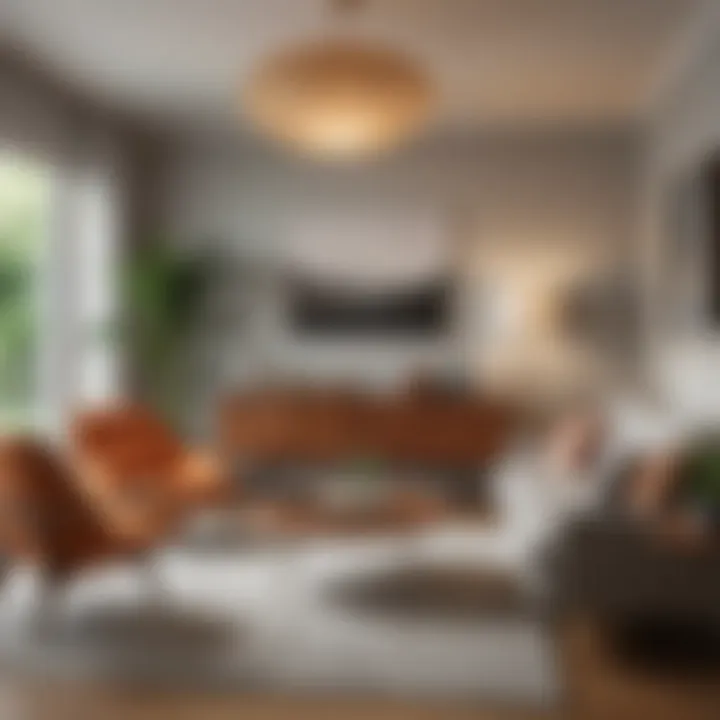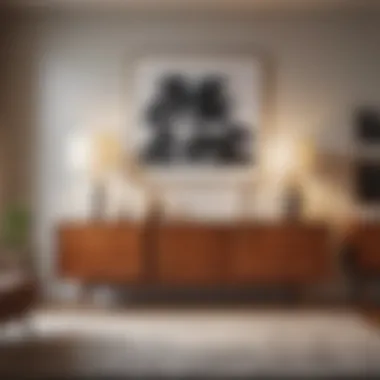Understanding Mid-Century Modern Design: A Comprehensive Exploration


Intro
Mid-century modern design emerged as a significant movement between the 1940s and 1960s, reflecting a unique blend of innovation, functionality, and simplicity. The style is characterized by clean lines, organic forms, and an emphasis on integrating with nature. Architects and designers sought to break away from traditional aesthetics and craft spaces that resonated with the changing social dynamics of the time. This exploration delves into various facets of mid-century modern design, enriching understanding of its lasting influence on architecture and interior design today.
Featured Homes
Mid-century modern homes are often celebrated for their unique architectural qualities. These residences typically emphasize open floor plans and integrate indoor and outdoor spaces, allowing for a harmonious living experience.
Architectural Highlights
Key features of mid-century modern architecture include:
- Flat planes: Rooflines are often low and horizontal, promoting a sense of openness.
- Large glass windows: These elements invite natural light and provide unobstructed views of nature.
- Integration with nature: Structures often blend seamlessly into their surroundings, utilizing natural materials like wood and stone.
- Sleek contours: The overall design is minimalist, focusing on functionality and aesthetic purity.
These homes encapsulate the ideals of the era and often resonate with those who appreciate both art and practicality within their living spaces.
Interior Design Themes
Inside, mid-century modern design continues to emphasize simplicity and functionality. The interior design often reflects:
- Minimalistic furnishings: Pieces are typically sparse but stylish, emphasizing form and function. Popular designs include the Eames Lounge Chair and the Florence Knoll Sofa.
- Bold color schemes: Earthy tones mixed with vibrant hues create visually stimulating environments. Colors like turquoise, mustard yellow, and olive green are commonly found.
- Smart use of space: Rooms are designed to maximize utility while maintaining an open feel. Multifunctional furniture, such as expandable dining tables or modular sofas, is prevalent.
Understanding these themes is crucial for those looking to infuse mid-century modern elements into their own homes.
Cultural Insights
The cultural backdrop of mid-century modern design is integral to its understanding. Influences such as post-war optimism and the rise of consumer culture shaped the tastes and needs of that era.
Historical Context
The end of World War II ushered in a wave of change. With economic expansion, homeownership became a reality for many Americans. This societal shift allowed designers and architects to focus on creating affordable yet stylish homes for the masses. Key figures like Richard Neutra and Charles and Ray Eames were instrumental, leveraging new materials and techniques to produce innovative designs.
Enduring Legacy
Mid-century modern design has not only shaped homes but has also influenced modern aesthetic sensibilities. Today, many contemporary creators draw inspiration from this era. Its principles are evident in current design trends emphasizing sustainability, reinterpretation of space, and connection with nature.
"Mid-century modern design is not merely a style; it is a philosophy that continues to influence today's architecture and interior design."
Ending
Prelims to Mid-Century Modern Design
Mid-century modern design remains a pivotal segment in the field of architecture and interior aesthetics. Understanding its core principles and context provides essential insight into a style that has profoundly influenced contemporary design. This section aims to illuminate key aspects of mid-century modern design, emphasizing its significance across various disciplines. By exploring its definition and historical backdrop, readers will gain a comprehensive appreciation for this enduring style.
Definition and Origins
Mid-century modern design refers to a design movement that emerged between the 1930s and the late 1960s. It's characterized by clean lines, integration with nature, and a focus on function. This design philosophy promotes simplicity and the idea that form follows function. Notably, it encompasses architecture, furniture, and other design elements, merging innovative construction methods with accessible materials.
The origins of mid-century modern design can be traced back to several cultural and social shifts occurring worldwide. Influences came from various sources, such as the Bauhaus school in Germany, which advocated functionalism and simplicity. Additionally, the impact of Scandinavian design cannot be overlooked. Designers sought to create spaces that were both aesthetically pleasing and functional. There was a drive to democratize design, making it available to the broader public.
Historical Context
To fully grasp mid-century modern design, one must consider the historical environment in which it developed. The end of World War II marked a significant turning point. This period saw a surge in economic prosperity in the United States. There was a rising demand for housing and consumer goods. At the same time, a cultural shift towards individualism encouraged personal expression through design.
The mid-20th century also witnessed significant technological advancements. New materials and methods, such as plywood and steel, altered how structures were conceived. Designers like Richard Neutra and Charles Eames capitalized on these innovations, pushing the boundaries of traditional design.
The role of international influences cannot be overstated. As global communication improved, various design philosophies began to merge. By integrating elements from diverse cultures, architects and designers were able to craft a uniquely modern yet deeply resonant style.
"Mid-century modern design is not merely an aesthetic; it embodies a specific set of values towards living and interacting with the environment."
Understanding these aspects sets the stage for appreciating the key characteristics that define mid-century modern design. Exploring how these historical influences shaped the style will deepen our grasp of its relevance and application today.
Key Characteristics
Mid-century modern design is rich with distinctive features that define its aesthetic and functionality. Understanding these characteristic elements is essential for anyone interested in architecture and design. This section delves into the important structural elements, design materials, and color palettes that form the foundation of this movement.
Structural Elements
Open Floor Plans
Open floor plans are a hallmark of mid-century modern design. They enhance the flow of space, which is vital for both living and entertaining. These layouts allow for seamless transitions between various areas, creating an inviting atmosphere. The key characteristic of open floor plans is their ability to maximize usable space while minimizing barriers. This design choice has significant benefits, such as fostering social interactions and allowing natural light to permeate different areas. However, one potential drawback is the lack of privacy in certain situations, which may concern some homeowners.


Large Windows
Large windows play a crucial role in mid-century modern architecture. They connect indoor spaces with the outdoors, reinforcing the idea of harmony with nature. A key characteristic of these windows is their size, which helps to flood interiors with natural light. This design feature is beneficial, as it improves mood and reduces the need for artificial lighting during the day. On the downside, large windows may require more energy-efficient solutions or specialized maintenance to ensure protection against the elements.
Integration with Nature
The integration with nature is a fundamental aspect of mid-century modern design. This approach emphasizes a strong relationship between the built environment and the surrounding landscape. A noticeable characteristic is how structures are often positioned to enhance views of nature and utilize natural materials. This element is advantageous because it promotes tranquility and sustainability. However, achieving this integration can sometimes pose challenges, particularly if the building site is not conducive to such designs.
Design Material Use
Timber
Timber has long been favored in mid-century modern design. It brings warmth and texture to spaces. The primary characteristic of timber is its versatility in both structural and aesthetic applications. It is a popular choice due to its sustainability and natural beauty. Timber adds unique features like grain patterns, which enrich the overall visual experience. Yet, maintenance can be demanding, as untreated wood is susceptible to weathering and pests.
Glass
Glass is another significant material in mid-century modern design. This element allows for expansive views and enhances natural light. The characteristic transparency of glass makes it a favored choice for walls and windows. It contributes to the open and airy feel of these spaces. While glass integrates well into designs, it can also present challenges, such as temperature regulation and privacy issues, which may require additional solutions.
Metal
Metal usage in mid-century modern designs is notable, particularly for furniture and structural elements. A key characteristic of metal is its durability and industrial aesthetic. This choice provides a contrast to more organic materials like wood. Metal's inclusion evokes a sense of modernity and sharp lines, which are cornerstones of mid-century design philosophy. Still, concerns about comfort and temperature can arise, as metal surfaces can be harsh in certain contexts.
Color Palettes
Earthy Tones
Earthy tones dominate the color schemes in mid-century modern design. These hues encourage a sense of warmth and connection to nature. The key characteristic of earthy tones is their ability to create a calming atmosphere. They blend effortlessly with natural materials, enhancing the overall feel of the space. While this palette fosters a harmonious environment, heavier reliance on these colors may make spaces feel too subdued for some tastes.
Bold Accents
Bold accents are used strategically in mid-century modern spaces. They inject life and vibrancy into otherwise neutral palettes. The characteristic of bold accents is their capacity to create focal points within a room. These accents can be showcased in furniture or artwork, helping to establish a unique identity for each space. However, overusing bold colors may lead to a disjointed or chaotic feel, which should be carefully managed.
Neutral Bases
Neutral bases form the backbone of mid-century modern color schemes. These tones provide a balanced foundation that supports both earthy colors and bold accents. The key characteristic of neutral bases lies in their versatility, making them suitable for various design styles. They create a sense of calm and allow for easy future updates. However, relying exclusively on neutral bases may lead to spaces that lack personality if not paired thoughtfully with other elements.
"Mid-century modern design seamlessly combines functionality and aesthetics, allowing for spaces that are not only beautiful but livable."
Influence of Culture on Mid-Century Modernism
Understanding the influence of culture on mid-century modernism adds context to how the design evolved during a distinct historical period. The post-war era shifted perspectives on architecture and design, leading to unique creations that reflected societal changes. This section examines how cultural shifts, technological advancements, and global influences played a vital role in shaping mid-century modern design.
Post-War America
After World War II, America saw a significant transformation in its social landscape. Returning soldiers were settling down, leading to an increased demand for housing. The resulting suburban boom fostered a sense of optimism and a desire for functional yet aesthetically pleasing living spaces. Architects and designers embraced innovative ideas, reshaping American homes with efficient layouts and modern materials.
The newfound appreciation for simplicity and practicality drove the design ethos. Homes became multifunctional spaces, mirroring the societal shift towards casual living and intimacy, which was prevalent during this time.
Technological Advancements
Technological progress marked another turning point. The advent of new materials like plywood, plastic, and aluminum allowed designers to experiment creatively. These materials were not only visually appealing, but also provided new functionalities, enabling lightweight yet sturdy structures.
Key innovations, such as the invention of air conditioning and advancements in construction techniques, led architects to prioritize open layouts and expansive glass walls. This shift further enhanced the relationship between internal spaces and the outdoors, a significant hallmark of mid-century modern design.
Global Influences
Cultural influences did not just emerge from within America; they were significantly shaped by ideas from around the world. Two prominent sources of inspiration were Scandinavian minimalism and Japanese aesthetics.
Scandinavian Minimalism
Scandinavian minimalism introduced themes of simplicity and functionality that resonate deeply within mid-century modernism. Characterized by clean lines, light colors, and an emphasis on craftsmanship, it presents an approachable yet sophisticated design style. This has proven to be a popular aspect because it promotes harmony with nature, emphasizing the use of natural materials and promoting user-friendly layouts.
A unique feature of Scandinavian minimalism is its ability to create serene environments using minimal decor. This leads to less clutter and helps individuals focus on essential elements, thus enhancing the overall living experience.
Japanese Aesthetics
Japanese aesthetics also significantly influenced mid-century modernism, with its principles of simplicity, balance, and connection to nature. Key characteristics include the use of natural light and materials, enhancing the serenity of spaces. This approach aligns well with the mid-century ethos of integrating the outdoors with interior living spaces.
A distinctive aspect of Japanese aesthetics is the emphasis on negative space, which promotes tranquility and thoughtfulness in design. This leads to an intentional use of space, encouraging mindfulness and reflecting a deep cultural tradition.
In summary, the interplay of post-war sentiments, technological advancements, and global aesthetics created a rich framework for mid-century modern design. Each element became a building block towards establishing a style that is both timeless and relevant in contemporary discussions.
Iconic Mid-Century Modern Architects
Mid-century modern architecture played a significant role in shaping the aesthetic principles of the 20th century. The contributions of iconic architects during this time helped establish the movement as a defining style. Understanding the influence of these architects is crucial in appreciating the depth of mid-century modern design.
Richard Neutra
Richard Neutra is often celebrated as one of the foremost figures in mid-century modern architecture. His designs embody a harmony with nature through their integration of indoor and outdoor spaces. Neutra's work frequently features large windows and open layouts that allow natural light to flow in, promoting a sense of transparency and connection with the environment.
Neutra's most recognized project, the Kaufmann Desert House in Palm Springs, showcases his pioneering approach to residential architecture. This structure combines functionality with striking aesthetics, representing a balance that is characteristic of mid-century modernism. His use of materials such as concrete and glass reflects a modernist philosophy that marries form with function.


Louis Kahn
Louis Kahn's contribution to architecture during the mid-20th century is distinct yet impactful. While he may not fully align with the traditional mid-century modern style, his work exemplifies elements that resonated with the movement. Kahn's designs emphasized monumental forms and the innovative use of light, granting his buildings a sense of weight and permanence.
The Salk Institute, located in La Jolla, California, is one of Kahn's seminal works. It represents his unique ability to blend space and light into the architectural experience. Kahn's focus on creating spaces that promote learning and reflection aligns subtly with the ideals of mid-century modernism, where functionality and user experience are paramount.
Charles and Ray Eames
Charles and Ray Eames are perhaps best known for their contributions to furniture design, yet their impact on architecture is equally significant. Their work transcends traditional boundaries of design, combining art and functionalism in ways that have become hallmarks of mid-century modernism. The Eames Lounge Chair is an iconic piece that continues to influence design today, characterized by its elegant curves and innovative use of materials.
The Eameses' architectural approach included the design of the Eames House, which reflects their principles of living harmoniously within one's environment. The house, made primarily from industrial materials, serves as a canvas for their philosophies on life and design.
"The role of the designer is that of a very good, thoughtful host anticipating the needs of his guests." - Charles Eames
In summary, the architects Richard Neutra, Louis Kahn, and Charles & Ray Eames brought unique perspectives to mid-century modern design. Their work continues to inspire and shape contemporary architecture, blending functional design with aesthetic integrity. Understanding their contributions provides deep insight into the values and ideals of mid-century modernism, enhancing appreciation for this influential design movement.
Furniture Design in Mid-Century Modernism
Furniture design is a key pillar in understanding mid-century modernism. It reflects the movement's commitment to simplicity, functionality, and a seamless integration with everyday life. Mid-century modern furniture has become synonymous with aesthetics that prioritize clean lines and innovative materials. These characteristics not only serve aesthetic purposes but also meet practical needs of users. With an emphasis on both form and function, furniture from this period enhances living spaces without overwhelming them.
Functionality and Form
The notion of merging functionality with form is central in mid-century modern furniture design. Designers sought to create pieces that were not just visually appealing but also practical. This approach leads to designs that accommodate modern living, allowing for ease of use and versatility.
- Simplicity in Design: Lines are often minimalist, avoiding excessive ornamentation. This makes the pieces adaptable to various interior styles.
- Innovative Use of Space: Furniture is designed to maximize space efficiency, fitting well within open floor plans that are typical of mid-century architecture.
- Ergonomics: Many pieces are crafted with the comfort of the user in mind, ensuring a pleasant interaction with furniture.
These elements contribute to living environments that feel airy and welcoming.
Notable Furniture Pieces
Eames Lounge Chair
The Eames Lounge Chair, designed by Charles and Ray Eames in 1956, stands as a hallmark of mid-century modern design. This piece combines comfort with elegance, setting a high standard for lounge seating. Its key characteristic lies in its ergonomic shape and luxurious materials. The chair's molded plywood and leather upholstery reflect meticulous craftsmanship designed for relaxation.
- Unique Feature: Its distinctive three-piece construction allows optimal comfort while maintaining visual appeal.
- Advantages for Users: The Eames Lounge Chair is a popular choice for both residential and commercial spaces, thanks to its iconic status and timeless design. However, it can be considered an investment, as high-quality reproductions and originals can carry a hefty price tag.
Noguchi Table
The Noguchi Table, designed by Isamu Noguchi in 1948, exemplifies the fusion of art and practical use. This sculptural coffee table features two interlocking shapes that provide stability. Its key characteristic is the use of natural materials such as wood and glass, emphasizing organic forms.
- Unique Feature: The design challenges the traditional notions of what furniture should be, merging functionality with artistic expression.
- Advantages: The Noguchi Table is versatile, fitting seamlessly into various decor styles, from minimalist to eclectic. Nonetheless, care should be taken as the glass top is vulnerable to damage.
"Mid-century modern furniture is not just functional; it embodies a philosophy of design that transcends its time."
Overall, both the Eames Lounge Chair and the Noguchi Table demonstrate the core principles of mid-century modernism. They enhance spaces while adhering to the stylistic ethos of the era, making them compelling choices for design aficionados.
Mid-Century Modern Interior Design
Mid-century modern interior design stands as a testament to a significant era in architectural history. This style emphasizes simplicity and functionality, making it influential even today. It embodies a philosophy that values form with a practical approach to living space. By understanding mid-century modern interior design, one can appreciate how it combines aesthetics with user-focused design elements.
Open Spaces and Lighting
A hallmark of mid-century modern design is the focus on open spaces. This approach promotes fluidity in living areas, allowing for a seamless flow between rooms. The philosophy is built on the belief that spaces should enhance interaction and connectivity among its users. Often, these designs eliminate unnecessary walls, creating expansive environments that feel both inviting and liberating.
Light plays a crucial role in this aesthetic. Large windows are common, allowing natural light to fill interiors. They create an airy feeling while providing views of the outside. This connection to nature encourages occupants to appreciate their surroundings. With strategic placement of windows, the blend of indoors and outdoors becomes even more pronounced. Moreover, designers incorporate varied lighting sources like pendant lights and floor lamps, enhancing the middle century ethos of functionality and beauty.
Bridging Indoor and Outdoor
Bridging the interior spaces with the exterior environment is another defining principle of mid-century modern design. The architecture often features sliding glass doors and terraces, fostering an inviting exchange between the two realms. This concept extends beyond mere aesthetics; it serves functional purposes too.
When interiors easily transition to outdoor spaces, it allows for a greater sense of scope. Homeowners can extend their living area, making it suitable for larger gatherings or quiet moments. Greenery becomes part of the internal ambiance. Furthermore, homes tend to incorporate natural materials, such as wood and stone, reflecting the surroundings.
"Mid-century modern design harmonizes structures with nature, illustrating an essential balance between man-made and organic."
To sum up, mid-century modern interior design prioritizes openness and harmony with nature. Understanding these elements enriches one's knowledge and appreciation of this influential style. The balance of light, space, and nature creates interiors that not only serve practical purposes but also elevate modern life.
Legacy and Influence Today
The legacy and influence of mid-century modern design continue to shape our architectural and interior landscapes today. Its principles emphasize functionality while retaining a strong aesthetic appeal. This style has successfully transcended its era, influencing how we approach design in various modern contexts. Not only does this movement reflect a unique historical perspective, but it also offers practical solutions for contemporary living spaces.
Mid-Century Modern in Contemporary Architecture


Mid-century modern architecture retains a significant presence in contemporary design. Many modern architects draw inspiration from this style, integrating its core principles into current projects. The emphasis on open floor plans and seamless transitions between indoor and outdoor spaces is a hallmark that echoes today. Notable buildings that reflect this influence include the Glass House by Philip Johnson and the Stahl House by Pierre Koenig. These structures showcase how mid-century elements can enhance modern architectural visions by providing clarity, simplicity, and elegance.
Resurgence of Interest
The resurgence of interest in mid-century modern design is palpable in today's consumer market. Many individuals seek to incorporate these timeless elements into their homes.
Design Shows and Publications
A notable facet of design shows and publications is their role in promoting mid-century modernism. Events such as the Palm Springs Modernism Week celebrate this style through exhibitions and panel discussions, reinforcing its relevance. The key characteristic of these events is their ability to connect designers and enthusiasts alike. They highlight restoration techniques and authentic furnishing methods, making them a valuable resource for aficionados. Additionally, publications like Dwell and Architectural Digest continually champion mid-century modernism, examining how it can be applied in contemporary settings. This visibility contributes to the overall popularity of the style among modern homeowners and interior designers.
Market Trends
Current market trends reflect a deepening appreciation for mid-century modern aesthetics. This style's characteristic simplicity and natural materials resonate with individuals prioritizing sustainability. Notably, there is a growing demand for vintage pieces as well as modern reproductions. This trend emphasizes the unique feature of mid-century design that blends nostalgia with functionality. The advantages are numerous—homeowners can achieve a sophisticated look with minimal clutter, while designers can create spaces that feel both classic and fresh. However, the popularity also leads to challenges, such as the risk of over-commercialization which may dilute authenticity.
"Mid-century modern design is not just a style; it is a philosophy rooted in the belief that form follows function, preserving the history while adapting to today’s needs."
In summary, the legacy of mid-century modern design persists, shaping our living environments and industry practices. Understanding its current relevance provides insights into the broader patterns in architecture and design today.
Practical Applications for Modern Homes
Mid-century modern design remains a relevant choice for many homeowners today. It is a style that inherently embodies simplicity, functionality, and elegance. This movement can seamlessly blend with contemporary elements and add a distinct flair to new constructions or renovations. Incorporating mid-century elements into modern homes can enhance aesthetic appeal and provide a sense of history and character that newer designs may lack.
Incorporating Mid-Century Elements
The essential goal of incorporating mid-century elements into modern homes is to create spaces that resonate with both nostalgia and modernity. Homeowners can start by selecting furniture that epitomizes this design movement. Iconic pieces include the Eames Lounge Chair or the Saarinen Tulip Table. These items not only serve practical functions but also act as conversation starters, connecting past and present aesthetics.
Key considerations for incorporating mid-century elements include:
- Color Choices: Earthy tones and bold accents are characteristic of mid-century designs. Using these colors can soften the harshness of stark contemporary designs.
- Material Selection: Prioritize materials like wood and metal. Furniture in walnut or teak reflects authentic mid-century craftsmanship.
- Open Space Planning: Embrace open floor plans that allow for free-flowing movement and light. This aspect aligns well with modern concepts of space utilization.
Integrating these elements creates an environment that feels timeless and unique. It invites warmth and familiarity, empowering homeowners to showcase their personality while adhering to a well-defined design philosophy.
Balancing Modern and Vintage
To strike a proper balance between modern and vintage elements, one has to be intentional. A home should narrate a story without feeling disjointed. Consider these tips for a harmonious mix:
- Accent Walls: Utilize wallpapers or paint several walls with vintage patterns while keeping other walls neutral. This creates a focal point while maintaining clean contemporary lines.
- Mix Furniture Styles: Combine modern seating with vintage side tables or lamps. This eclectic approach ensures no single style dominates, making the environment more inviting.
- Layering Textures: Use textiles, such as a shag rug from the mid-century era juxtaposed against sleek modern décor. Textures create depth and interest, which enhances the overall experience.
"A balanced home reflects the soul of its inhabitants, combining layers of experiences through design."
Achieving this balance is essential. It cultivates a cohesive space that transcends time periods yet feels contemporary. Thus, by thoughtfully incorporating mid-century elements into modern homes, one can enhance visual harmony and encapsulate a richer narrative than any single aesthetic could provide.
Challenges and Misconceptions
The discussion surrounding mid-century modern design is often colored by various challenges and misconceptions within the field. Understanding these challenges is vital, as it aids in appreciating the design’s deep-rooted values and nuances. Misinterpretations can lead enthusiasts to adopt a superficial view of this rich architectural and design era, undermining its significance and thorough appreciation. This section aims to clarify common misconceptions while highlighting important considerations that anyone interested in mid-century modernism should be aware of.
Over-commercialization of the Style
One prominent issue facing mid-century modern design today is the over-commercialization of its aesthetic. The original principles focused on simplicity, functionality, and a strong connection with nature. However, as styles evolve, many contemporary businesses lean towards replicating and commodifying mid-century modern pieces, often missing the essence of what made them unique. These replicas flood the market, making it challenging for consumers to distinguish authentic design from mass-produced knock-offs.
This trend often results in a dilution of the style’s inherent philosophy. Consumers may feel pressured to purchase items marketed as authentic while they are merely imitations influenced by mid-century shapes and forms. Consequently, discerning enthusiasts often have difficulty finding true representations of the art movement. As a result, many sacrifice quality and authenticity for trendiness and low cost.
To navigate this, buyers must prioritize learning about the original designers and their works. Engaging with reputable sources and establishing a strong understanding of what defines genuine mid-century modern design can encourage more informed purchases. This further supports artisans and companies committed to preserving the authenticity and integrity of the style.
Sustainability Concerns
Sustainability is another significant concern regarding mid-century modernism. As the interest in this aesthetic surges, so does the environmental impact associated with producing new goods that mimic the original designs. The mass production of furniture and decor items not only uses valuable resources but often leads to increased waste. This situation places mid-century modern aficionados in a contradictory position. On one hand, they admire the innovation and creativity of the period; on the other hand, they are faced with sustainability challenges when replicating its elements.
In response to these challenges, individuals should consider sourcing vintage pieces rather than buying new imitations. Local thrift stores, estate sales, or online marketplaces often offer authentic mid-century modern items that are not only eco-friendly but also rich in history. Reusing existing goods reduces the demand for mass production, thereby contributing to sustainable practices.
"Choosing vintage mid-century modern pieces can also add character to modern spaces while honoring the craftsmanship of the era."
Finale
The conclusion of this article serves as a crucial synthesis of the discussed topics relating to mid-century modern design. This design movement, emerging mid-20th century, has not merely dictated aesthetic principles but has also influenced our lived environments. Understanding its relevance today is vital for anyone interested in design, architecture, or real estate.
Relevance of Mid-Century Modern Design
Mid-century modern design continues to resonate with contemporary audiences. Its emphasis on simplicity and functionality aligns perfectly with current trends seeking minimalism and open spaces. Architectural features such as large windows and integration with nature invite natural light and outdoor elements, enhancing the living experience. For homeowners and designers alike, recognizing these key elements is essential for creating spaces that promote comfort and connection to the environment. Moreover, the use of authentic materials like timber and glass is gaining favor, as sustainability becomes a significant consideration in modern design practices.
Future Perspectives
Looking forward, the influence of mid-century modern design is expected to grow. As society increasingly values sustainability, the principles deployed by mid-century architects could serve as a model. Expect to see a resurgence in interest for authentic styles and vintage furniture within modern renovations.
By appreciating the core values of this design era, those engaged in home renovation or new constructions can harness its essence while making choices that are environmentally conscious. The past will continue to inform the future, and mid-century modern design may well offer valuable lessons for sustainable living.
"Design is not just what it looks like and feels like. Design is how it works.” - Steve Jobs
These transitional thoughts underline the importance of mid-century modern design in both achieving aesthetic fulfillment and addressing modern-day challenges, particularly in environmental sustainability.







